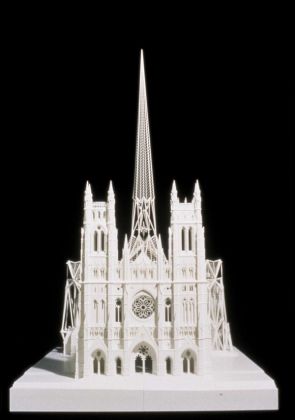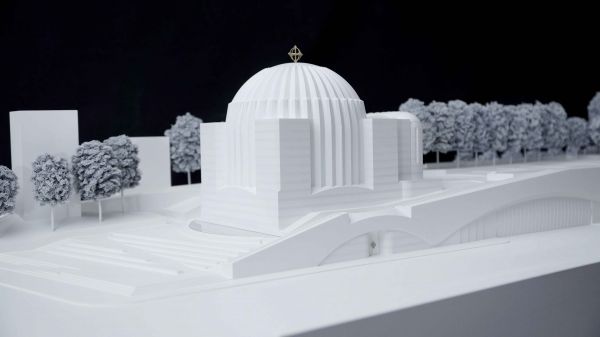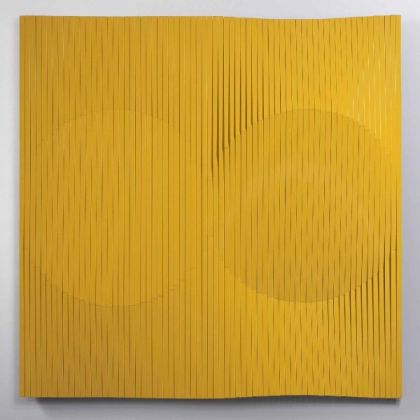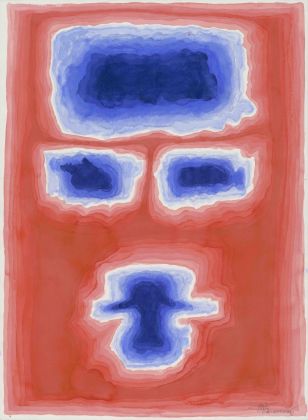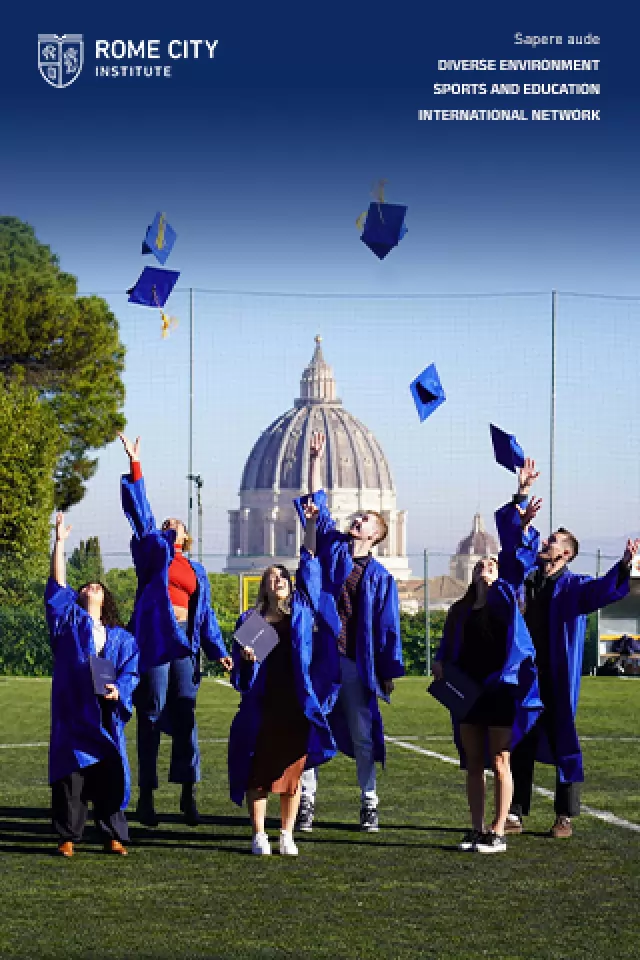First Vatican exhibition dedicated to a living architect
The work of celebrated Spanish architect, structural engineer, sculptor and painter Santiago Calatrava is the subject of a major exhibition at the Vatican's Braccio di Carlo Magno, in the south colonnade of St Peter’s Square, until 20 February.
Entitled Le Metamorfosi dello spazio, the exhibition offers a comprehensive representation of Calatrava's diverse artistic oeuvre, juxtaposing marble, bronze and wooden models of his signature architectural projects with his sculpture, paintings and sketches.
Given the location of the exhibition, it is perhaps unsurprising that churches and religious-themed art feature highly in the 140 works on show. Among the highlights is Calatrava’s model for the St Nicholas Greek Orthodox church planned for the Ground Zero site in New York, on public display for the first time. The original church was destroyed when Tower 2 of the World Trade Center collapsed on 11 September 2001. Calatrava says his new church, just over 17m in height, is intended to be “like a powerful flower in the centre of an area with immense dimensions.”
Another prominently-displayed piece is a model for his completion project for the Cathedral of St John the Divine, also in New York. Calatrava's radical but unapproved solution comprised a glass-encased biosphere around the nave of the enormous Episcopalian church, which remains in a permanently unfinished state even though its construction began some 120 years ago.
Further on, this elaborate plan is contrasted by the humble, cabin-like design for the Los Angeles Chapel, dedicated to Fr Junípero Serra, a Spanish Franciscan friar sent in 1767 to the missions of the “Baja California”. Calatrava's simplistic, open-plan design for the new chapel was inspired by the combined reverence for nature and sacred space found in the original hut-church. The walls are designed to rise, open up and spread like the wings of a dove, so making an open-air space under what then becomes a hanging roof. Here indeed is the metamorphosis of space seen in action; however, the church has never been built.
There is a strong international feel to the exhibition which includes designs for Calatrava's Puente de la Mujer bridge in Buenos Aires (2001), his Malmö Turning Torso skyscraper (2007), and the 600-m Chicago Spire, which would have been the tallest building in north America had its planned construction not fallen through in 2010.
Closer to home, the exhibition features an intricate model of the Città dello Sport di Roma, a grandiose project which began in 2005 and has since foundered. Located in the Rome suburb Tor Vergata, the sports complex was originally designed for the World Swimming Championships in 2009 and construction work began under the administration of former mayor Walter Veltroni. However the project soon ran out of funds and was abandoned. Now something of a white elephant, efforts are being made to obtain the roughly €500 million funds necessary to complete the project from private investors.
Visitors to the exhibition will probably be surprised to see so many paintings, many of them finished recently, including a giant pair of trees near the entrance, his large crouching figures, and the Genesi della cupola series of ten watercolour sketches which follow the metamorphosis of a Madonna into a church dome, then taken up in the design of church of St Nicolas, displayed opposite. His sculptures include the aluminium Morphing Yellow, the wooden Cascade, and the white alabaster Endless Light.
However, while the Vatican has gone to great lengths decorating the prestigious exhibition space with brightly coloured display panels, many of the explanatory labels are placed so low and are so dimly lit that it is difficult to read the titles.
Although this is not Calatrava's first exhibition in Rome (the Scuderie del Quirinale dedicated a show to him in 2007 entitled Dalle forme all'Architettura) it is, significantly, the first time that the Vatican honours a living architect with an exhibition. This follows the success of the Holy See's inaugural pavilion at the 2013 Venice Biennale. The Vatican's participation at the Biennale was spearheaded by Cardinal Gianfranco Ravasi, the dynamic head of the Pontifical Council for Culture, which is behind Calatrava's exhibition.
The exhibition reflects "the continued opening of the Vatican and the Church to the art of our time,” said Micol Forti, the head curator of contemporary art at the Vatican Museums and curator of the Calatrava show. At the inauguration, Forti explained that the title of the show, “The metamorphosis of space”, refers to “the main narrative thread in Calatrava’s work, which is the possibility of defining a new spatial harmony.”
Based between Zurich and New York, Calatrava is one of the world's most distinguished late-20th century architects, best known for his distinctive sculptural bridges – often cantilevered or cable-stayed and almost always in his signature white – in numerous cities around the world. These include the Samuel Beckett and James Joyce bridges in Dublin, the Alamillo Bridge in Seville, the Jerusalem Chords Bridge, and the Margaret Hunt Hill Bridge in Dallas.
However, despite being feted around the world, Calatrava is no stranger to controversy. The 62-year old architect is famed for cost over-runs and delayed completion of projects. In May 2012 the left-wing Spanish political party Esquerra Unida i Alternativa accused Calatrava of "bleeding Valencia dry" after claiming that the architect had charged some €100m to the financially-strapped regional government of his native city.
Calatrava's design for the Peace Bridge, an elegant 130-m pedestrian bridge in the Canadian city of Calgary, was originally scheduled for completion in autumn 2010 but due to numerous problems, including welding that didn't comply with Canadian quality standards, it was not opened until spring 2012.
Calatrava's futuristic train station, the World Trade Center Transportation Hub, is currently being built in New York. The extravagant design, which Calatrava described as like "a bird being released from a child's hand", has been scaled back to eliminate the opening and closing roof mechanism, over budget and space constraints. It is expected to open in 2015, six years behind schedule, at a cost of $4 billion, twice the original budget.
Calatrava's other projects in Italy include the new state-of-the-art railway station Medio Padana, the only stop on the Milan-Bologna high-speed line. Situated about halfway between Parma and Bologna in northern Italy, the white steel and glass wave-like station was inaugurated in June 2013.
Calatrava also designed the Ponte della Costituzione over the Grand Canal in Venice. Prior to its 2008 inauguration the arched truss bridge caused disquiet among locals, chiefly over concerns that its modernist-minimalist design was incompatible with the city's architectural heritage, but it has since become accepted to such an extent that it is referred to locally as the “Calatrava Bridge.”
The Vatican exhibition is open until 20 February every day from 10.00-18.00 except on Wednesdays, when it opens from 14.00-18.00. Braccio di Carlo Magno, Piazza S. Pietro, Vatican City.
Andy Devane
From 8 January edition Wanted in Rome



